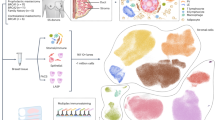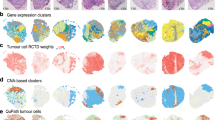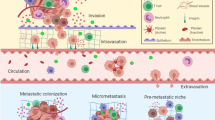Abstract
We previously identified loci in the mouse genome that substantially influence the metastatic efficiency of mammary tumors. Here, we present data supporting the idea that the signal transduction molecule, Sipa1, is a candidate for underlying the metastasis efficiency modifier locus Mtes1. Analysis of candidate genes identified a nonsynonymous amino acid polymorphism in Sipa1 that affects the Sipa1 Rap-GAP function. Spontaneous metastasis assays using cells ectopically expressing Sipa1 or cells with knocked-down Sipa1 expression showed that metastatic capacity was correlated with cellular Sipa1 levels. We examined human expression data and found that they were consistent with the idea that Sipa1 concentration has a role in metastasis. Taken together, these data suggest that the Sipa1 polymorphism is one of the genetic polymorphisms underlying the Mtes1 locus. This report is also the first demonstration, to our knowledge, of a constitutional genetic polymorphism affecting tumor metastasis.
This is a preview of subscription content, access via your institution
Access options
Subscribe to this journal
Receive 12 print issues and online access
$209.00 per year
only $17.42 per issue
Buy this article
- Purchase on Springer Link
- Instant access to full article PDF
Prices may be subject to local taxes which are calculated during checkout







Similar content being viewed by others
References
Liotta, L.A. & Stetler-Stevenson, W.G. Principles of Molecular Cell Biology of Cancer: Cancer Metastasis, 134–149 (J.B. Lippincott Co., Philadelphia, 1993).
Heimann, R., Lan, F., McBride, R. & Hellman, S. Separating favorable from unfavorable prognostic markers in breast cancer: the role of E-cadherin. Cancer Res. 60, 298–304 (2000).
Guy, C.T., Cardiff, R.D. & Muller, W.J. Induction of mammary tumors by expression of polyomavirus middle T oncogene: A transgenic mouse model for metastatic disease. Mol. Cell. Biol. 12, 954–961 (1992).
Lifsted, T. et al. Identification of inbred mouse strains harboring genetic modifiers of mammary tumor age of onset and metastatic progression. Int. J. Cancer 77, 640–644 (1998).
Hunter, K.W. et al. Predisposition to efficient mammary tumor metastatic progression is linked to the breast cancer metastasis suppressor gene Brms1. Cancer Res. 61, 8866–8872 (2001).
Seraj, M.J., Samant, R.S., Verderame, M.F. & Welch, D.R. Functional evidence for a novel human breast carcinoma metastasis suppressor, BRMS1, encoded at chromosome 11q13. Cancer Res. 60, 2764–2769 (2000).
Park, Y.G. et al. Comparative sequence analysis in eight inbred strains of the metastasis modifier QTL candidate gene Brms1. Mamm. Genome 13, 289–292 (2002).
Hitzemann, R. et al. Multiple cross mapping (MCM) markedly improves the localization of a QTL for ethanol-induced activation. Genes Brain Behav. 1, 214–222 (2002).
Wiltshire, T. et al. Genome-wide single-nucleotide polymorphism analysis defines haplotype patterns in mouse. Proc. Natl. Acad. Sci. USA 100, 3380–3385 (2003).
Park, Y.G., Clifford, R., Buetow, K.H. & Hunter, K.W. Multiple cross and inbred strain haplotype mapping of complex-trait candidate genes. Genome Res. 13, 118–121 (2003).
Tsukamoto, N., Hattori, M., Yang, H., Bos, J.L. & Minato, N. Rap1 GTPase-activating protein SPA-1 negatively regulates cell adhesion. J. Biol. Chem. 274, 18463–18469 (1999).
Hitzemann, R. et al. A strategy for the integration of QTL, gene expression, and sequence analyses. Mamm. Genome 14, 733–747 (2003).
Steeg, P.S. Metastasis suppressors alter the signal transduction of cancer cells. Nat. Rev. Cancer 3, 55–63 (2003).
Bois, P. et al. Isolation and characterization of mouse minisatellites. Genomics 50, 317–330 (1998).
Nakamura, Y., Koyama, K. & Matsushima, M. VNTR (variable number of tandem repeat) sequences as transcriptional, translational, or functional regulators. J. Hum. Genet. 43, 149–152 (1998).
Bailly, S., Israel, N., Fay, M., Gougerot-Pocidalo, M.A. & Duff, G.W. An intronic polymorphic repeat sequence modulates interleukin-1 alpha gene regulation. Mol. Immunol. 33, 999–1006 (1996).
van Ham, M. & Hendriks, W. PDZ domains-glue and guide. Mol. Biol. Rep. 30, 69–82 (2003).
Hogue, C.W. Cn3D: a new generation of three-dimensional molecular structure viewer. Trends Biochem. Sci. 22, 314–316 (1997).
Altschul, S.F. et al. Gapped BLAST and PSI-BLAST: a new generation of protein database search programs. Nucleic Acids Res. 25, 3389–3402 (1997).
Kurachi, H. et al. Human SPA-1 gene product selectively expressed in lymphoid tissues is a specific GTPase-activating protein for Rap1 and Rap2. Segregate expression profiles from a rap1GAP gene product. J. Biol. Chem. 272, 28081–28088 (1997).
Noda, Y. et al. Aquaporin-2 trafficking is regulated by PDZ-domain containing protein SPA-1. FEBS Lett. 568, 139–145 (2004).
Pei, X.F. et al. Explant-cell culture of primary mammary tumors from MMTV-c-Myc transgenic mice. In Vitro Cell. Dev. Biol. Anim. 40, 14–21 (2004).
Gao, Q., Srinivasan, S., Boyer, S.N., Wazer, D.E. & Band, V. The E6 oncoproteins of high-risk papillomaviruses bind to a novel putative GAP protein, E6TP1, and target it for degradation. Mol. Cell. Biol. 19, 733–744 (1999).
Gould, K.A. et al. Genetic evaluation of candidate genes for the Mom1 modifier of intestinal neoplasia in mice. Genetics 144, 1777–1785 (1996).
Sledz, C.A., Holko, M., de Veer, M.J., Silverman, R.H. & Williams, B.R. Activation of the interferon system by short-interfering RNAs. Nat. Cell Biol. 5, 834–839 (2003).
Snove, O., Jr. & Holen, T. Many commonly used siRNAs risk off-target activity. Biochem. Biophys. Res. Commun. 319, 256–263 (2004).
Dhanasekaran, S.M. et al. Delineation of prognostic biomarkers in prostate cancer. Nature 412, 822–826 (2001).
LaTulippe, E. et al. Comprehensive gene expression analysis of prostate cancer reveals distinct transcriptional programs associated with metastatic disease. Cancer Res. 62, 4499–4506 (2002).
Bhattacharjee, A. et al. Classification of human lung carcinomas by mRNA expression profiling reveals distinct adenocarcinoma subclasses. Proc. Natl. Acad. Sci. USA 98, 13790–13795 (2001).
Garber, M.E. et al. Diversity of gene expression in adenocarcinoma of the lung. Proc. Natl. Acad. Sci. USA 98, 13784–13789 (2001).
Ramaswamy, S., Ross, K.N., Lander, E.S. & Golub, T.R. A molecular signature of metastasis in primary solid tumors. Nat. Genet. 33, 49–54 (2003).
Miele, M.E. et al. Metastasis suppressed, but tumorigenicity and local invasiveness unaffected, in the human melanoma cell line MelJuSo after introduction of human chromosomes 1 or 6. Mol. Carcinog. 15, 284–299 (1996).
Sekita, N. et al. Epigenetic regulation of the KAI1 metastasis suppressor gene in human prostate cancer cell lines. Jpn. J. Cancer Res. 92, 947–951 (2001).
Khanna, C. & Hunter, K. Modeling metastasis in vivo. Carcinogenesis 26, 513–523 (2005).
Pharoah, P.D. et al. Polygenic susceptibility to breast cancer and implications for prevention. Nat. Genet. 31, 33–36 (2002).
Day, N. et al. EPIC-Norfolk: study design and characteristics of the cohort. European prospective investigation of cancer. Br. J. Cancer 80 Suppl 1, 95–103 (1999).
Hattori, M. et al. Molecular cloning of a novel mitogen-inducible nuclear protein with a Ran GTPase-activating domain that affects cell cycle progression. Mol. Cell. Biol. 15, 552–560 (1995).
Ohba, Y. et al. Requirement for C3G-dependent Rap1 activation for cell adhesion and embryogenesis. EMBO J. 20, 3333–3341 (2001).
Yajnik, V. et al. DOCK4, a GTPase activator, is disrupted during tumorigenesis. Cell 112, 673–684 (2003).
Seftor, E.A. et al. Molecular determinants of human uveal melanoma invasion and metastasis. Clin. Exp. Metastasis 19, 233–246 (2002).
Stork, P.J. Does Rap1 deserve a bad Rap? Trends Biochem. Sci. 28, 267–275 (2003).
Farina, A. et al. Bromodomain protein Brd4 binds to GTPase-activating SPA-1, modulating its activity and subcellular localization. Mol. Cell. Biol. 24, 9059–9069 (2004).
Ishida, D. et al. Myeloproliferative stem cell disorders by deregulated Rap1 activation in SPA-1-deficient mice. Cancer Cell 4, 55–65 (2003).
Hunter, K., Welch, D.R. & Liu, E.T. Genetic background is an important determinant of metastatic potential. Nat. Genet. 34, 23–24 (2003).
Hunter, K.W. Allelic diversity in the host genetic background may be an important determinant in tumor metastatic dissemination. Cancer Lett. 200, 97–105 (2003).
Hunter, K.W. Host genetics and tumour metastasis. Br. J. Cancer 90, 752–755 (2004).
Gordon, D., Abajian, C. & Green, P. Consed: a graphical tool for sequence finishing. Genome Res. 8, 195–202 (1998).
Le Voyer, T. et al. An epistatic interaction controls the latency of a transgene-induced mammary tumor. Mamm. Genome 11, 883–889 (2000).
Hedenfalk, I. et al. Gene-expression profiles in hereditary breast cancer. N. Engl. J. Med. 344, 539–548 (2001).
Acknowledgements
We thank B. Ponder and the members of the Laboratory of Population Genetics for discussions and A. Papageorge and V. Bliskovsky for technical assistance and discussions. This research was supported in part by the Intramural Research Program of the US National Institutes of Health, the US National Cancer Institute and the Center for Cancer Research.
Author information
Authors and Affiliations
Corresponding author
Ethics declarations
Competing interests
The authors declare no competing financial interests.
Supplementary information
Supplementary Table 1
Genes differentially expressed between RNAi and control cell lines. (XLS 56 kb)
Supplementary Table 2
Oligos used in this study. (PDF 8 kb)
Rights and permissions
About this article
Cite this article
Park, YG., Zhao, X., Lesueur, F. et al. Sipa1 is a candidate for underlying the metastasis efficiency modifier locus Mtes1. Nat Genet 37, 1055–1062 (2005). https://doi.org/10.1038/ng1635
Received:
Accepted:
Published:
Issue Date:
DOI: https://doi.org/10.1038/ng1635
This article is cited by
-
A novel transcription factor SIPA1: identification and verification in triple-negative breast cancer
Oncogene (2023)
-
Insights from transgenic mouse models of PyMT-induced breast cancer: recapitulating human breast cancer progression in vivo
Oncogene (2021)
-
Dissecting the critical pathway crosstalk mechanisms of thyroid cancer based on drug-target genes and disease genes
Biologia (2021)
-
A scan for genes associated with cancer mortality and longevity in pedigree dog breeds
Mammalian Genome (2020)
-
Genetic insights into the morass of metastatic heterogeneity
Nature Reviews Cancer (2018)



